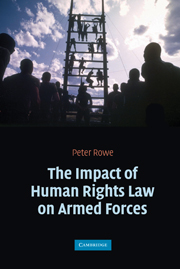Book contents
- Frontmatter
- Contents
- Preface
- 1 Human rights within the context of members of armed forces
- 2 The human rights of members of the armed forces
- 3 Human rights and the disciplinary process
- 4 Civilians before military courts
- 5 Human rights and international armed conflict
- 6 Human rights, non-international armed conflict and civil disorder
- 7 Human rights during multinational operations
- Index
Preface
Published online by Cambridge University Press: 12 January 2010
- Frontmatter
- Contents
- Preface
- 1 Human rights within the context of members of armed forces
- 2 The human rights of members of the armed forces
- 3 Human rights and the disciplinary process
- 4 Civilians before military courts
- 5 Human rights and international armed conflict
- 6 Human rights, non-international armed conflict and civil disorder
- 7 Human rights during multinational operations
- Index
Summary
This book attempts to consider those aspects of human rights law which may become relevant to the activities of armed forces whether they remain in barracks, undertake training or are deployed in military operations within their own State or outside it. In particular, it considers, from a human rights perspective, the position of members of those armed forces and those with whom they will come into contact during some form of military operation.
The unique nature of military service and of military courts gives rise to human rights issues in respect of those who serve in armed forces, whether as volunteers or as conscripts, and of civilians who find themselves placed before military courts. Chapters 1 to 4 explore the application of human rights standards in this military context.
It is often, however, part of the function of armed forces to take part in armed conflict, or at least to train for such a possibility. In this case international humanitarian law will also apply alongside the human rights obligations of the State in certain circumstances. Since the former body of law draws a distinction between international and non-international armed conflicts, whilst the latter does not, I have considered it appropriate to make such a distinction in order to consider the different nature of, and issues involved in, such conflict from both a human rights and an international humanitarian law standpoint.
- Type
- Chapter
- Information
- The Impact of Human Rights Law on Armed Forces , pp. ix - xiiPublisher: Cambridge University PressPrint publication year: 2005

